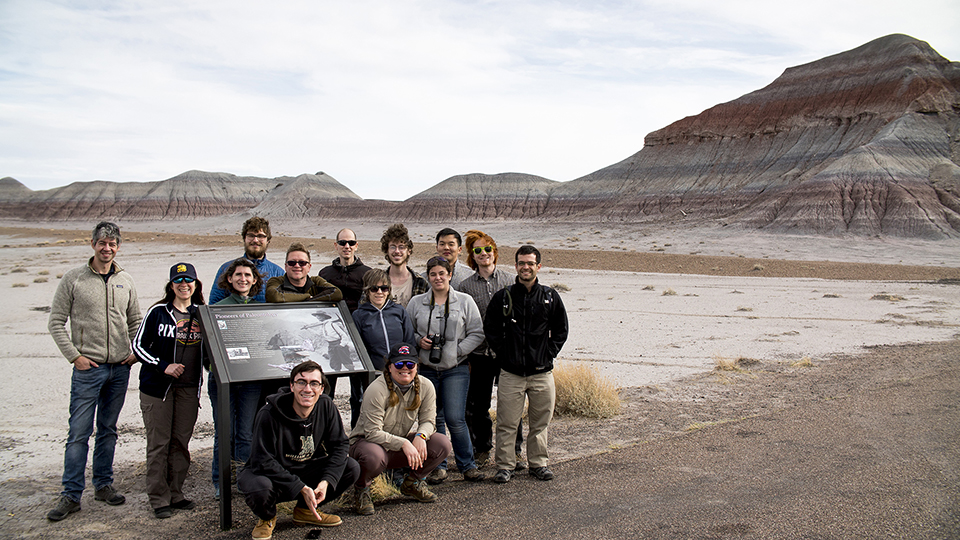
Four states, nine days, 2,850 miles, 48 hours cumulative driving and enumerable sponges. The Field Methods in Paleobiology Course, also known as the 2018 Spring Break Field Trip, from March 24, 2018 to April 1, 2018, was a whirlwind tour of the Southwest with IB Faculty/UCMP Curators Cindy Looy, Ivo Duijnstee and Seth Finnegan leading a group of students, a professor on sabbatical and one staff member to West Texas to the explore the ancient Capitan Reef formation in and around Guadalupe Mountains National Park. This field trip would take the class to Petrified Forest National Park, Carlsbad Caverns National Park, Guadalupe Mountains National Park and Organ Pipe Cactus National Monument among other geologically interesting sites. The Field Methods in Paleobiology course started early in the semester with Cindy, Ivo and Seth facilitating presentations made by the students describing the paleogeography and paleobiology of the sites we planned to visit.
The video below was taken in Kinny Brick Quarry, with permission from quarry owner.
Day 1: Leaving UC Berkeley
We began our journey with some long haul driving from UC Berkeley to Kingman AZ, a city on historic route 66 just 20 minutes from the border between California and Arizona and left bright and early the next morning towards our next stop: Petrified Forest National Park.
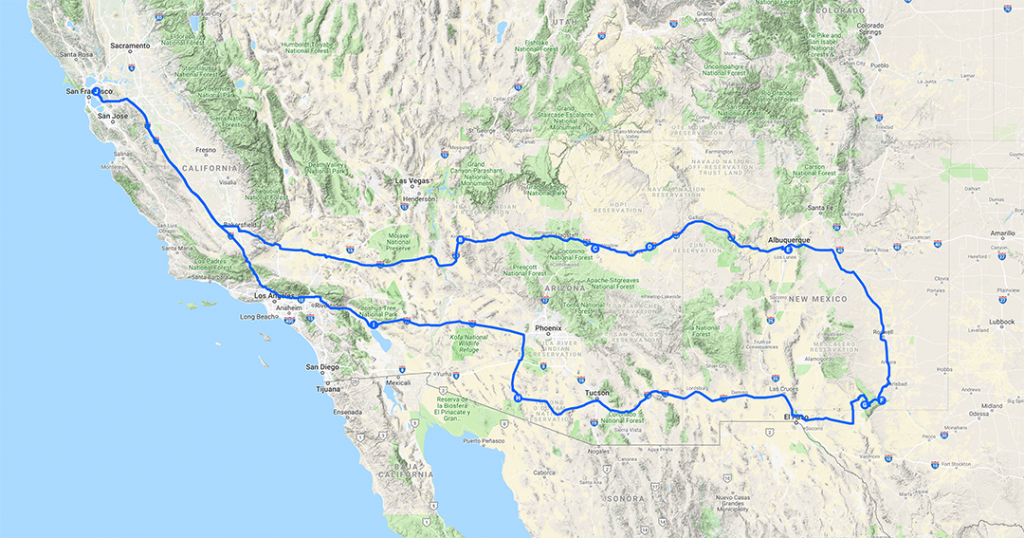
Day 2: Space Rocks and Petrified Forests

While making our way to Petrified Forest National Park, we stopped at Meteor Crater Natural Landmark, a place where rocks from space met rocks from Earth. The immense power from the impact of the meteor overturned the original layers of rock, leaving the oldest layer, the Cococino sandstone, at the top rim of the crater. The crater measures 1200 m (3,900 ft) in diameter and 120 m (560 ft) in depth.
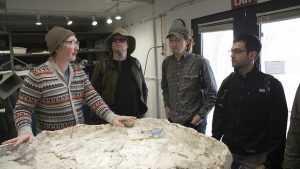
Next, we drove out to Petrified Forest National Park and met with friend and NPS Ranger Charles (Chuck) Beightol who gave us a tour of the prep lab and paleontology collections. Along with the petrified conifers, PEFO also holds some amazing fossil reptiles. Crocodile-like phytosaurs and armored aetosaurs are among their most well-known fossils.
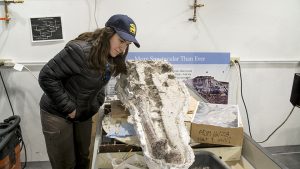
The signature feature of PEFO is the Painted Desert, a vast area filled with beautiful multi-colored rock formations. The colors come from the different stages of oxidation of minerals, mainly iron and manganese, mixed with volcanic ash that collected in the area many millions of years ago. Over time (geologic time), water repeatedly flooded and cut into the rock, further depositing minerals, and resulting in the brightly colored and contrasting layered bands seen in the Teepee and Butte geologic formations. The same process also gave the petrified conifers and fossils their unique color.
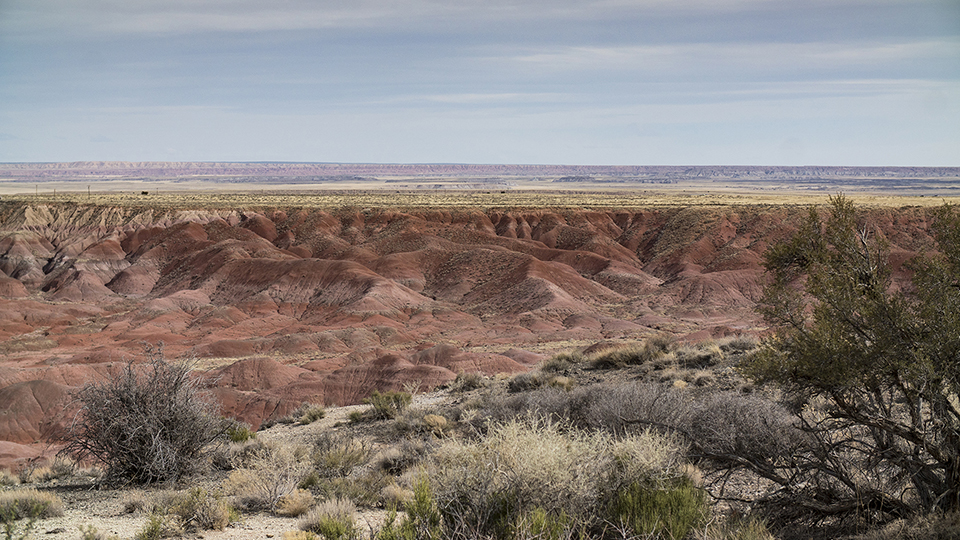
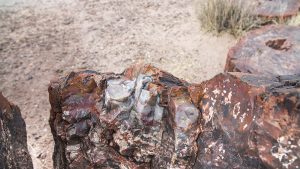
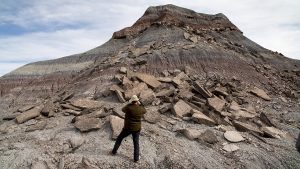
Historically important to the UCMP, we visited a spot near the Teepees where an interpretive panel celebrated “Pioneers of Paleontology,” namely UCMP founder Annie Alexander and paleontologist Charles Camp. Finally, we left for Arizona for Albuquerque NM, host city for the 2018 Society of Vertebrate Paleontology Conference in October.
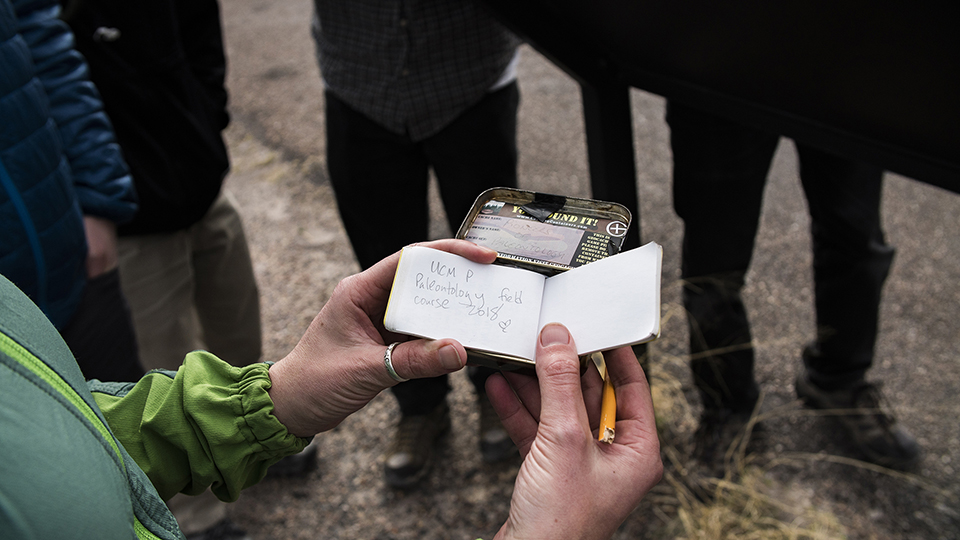
Day 3: Kinney Brick Quarry
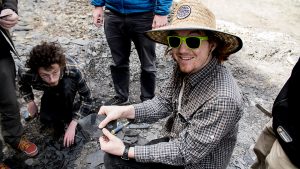
Our next stop was an exciting one, visiting Kinney Brick Quarry to collect fossils! We were graciously invited to an offsite quarry owned by Kinney Brick Co., a clay brick manufacturer, with paleontologist Spencer Lucas of the University of New Mexico and owner, Ralph Hoffman. This site is unique in that it is an active quarry, and we were allowed to dig before the clay was trucked away for brick manufacturing. This area is known as a lagerstätte in the Pennsylvanian. This unique clay and lagoonal pool combination meant many different plants and animals washed into the area, creating a treasure trove of fossils. The fine clay was an ideal substrate to preserve the details of the fossils. Pteridophytes, lycopods, molluscs and even fish were found on our dig.
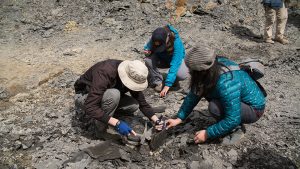

Day 4: Carlsbad Caverns National Park
A brief visit from a local road runner served as a good omen as we hit the ‘road running’ in the morning and made our way to Carlsbad Caverns National Park to trek into the largest cave system in North America. The Carlsbad Caverns is a system of caves that were once part of a Permian reef in the Delaware Basin of Texas and New Mexico. Over time, sulfuric acid dissolved most of the limestone, leaving incredibly vast cavities where one could readily imagine large prehistoric creatures swimming through, living their best prehistoric lives. These days, speleothems (cave formations) made of gypsum are present in this cave along with interesting stops like the “Bottomless Pit,” evidence of the cave’s early explorers still present today.
Back on the road, we stopped to explore another exposed outcrop in nearby Walnut Canyon and met up with a geology class taught by Seth Finnegan’s colleague and friend Professor Shanan Peters from University of Wisconsin, Madison. This was a first look at some nicely exposed marine invertebrate fossils, an indication of what we would see on our McKittrick Canyon hike the next day. Unfortunately, rain clouds interrupted our exploration of this part of the ancient reef system. We set off to our camp site right over the state line at Guadalupe Mountains National Park in West Texas. The rain was still coming down during our dinner prep and we tailgated to keep our food prep dry.
Day 5: Permian Reef Trail in McKittrick Canyon at GUMO
The group got up bright and early for our next adventure: hiking up Permian Reef Trail in McKittrick Canyon in Guadalupe Mountains National Park (GUMO). While the views of Texas and New Mexico from top of the trail were gorgeous, for our group the most interesting views were directly beneath our feet. Our time was spent hiking was easily 20% of the hike itself, the other 80% was spent with faces pressed the against the rock looking for more signs of prehistoric life. The rest of the reef patiently waited for us to climb.
Fossilized marine invertebrates were easily found in the limestone right on the trail. Crinoids, corals and rugose sponges were plentiful lower in the canyon, but as we progressed up the trail we encountered more cellularly complex creatures. We saw net-shaped fenestrated bryozoans and eventually encountered a key fossil group of extinct foramifera called fusilinids. One of the largest microfossils, these cigar shaped forams are also rare in occurance, making them great index fossils. We also saw evidence of trilobites and nautiliods as we ascended. After a long trek up to the top, we saw the expansive views of Texas and New Mexico. If not for these exposures, it would be even more difficult to imagine the entire canyon including El Capitan, the second highest peak in Texas, being underwater nearly 300 million years ago.
Day 6: Science on the road and off the road.
Road cuts highlighted the interesting geology of the Brushy Canyon Formation. This area was paleogeographically further away from the reef, showing us the floor of the lower depth of the sea. Here the group observed a large scale flow deformation feature in the sandstone, with layers of siltstone in between. Looking behind us, we could see the edge of the reef we had explored the day before. We spent some time off-roading and spelunking at the Parks Ranch Campground.
Day 7: West of Texas
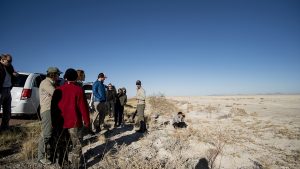
After 3 nights at Guadalupe Mountains National Park, we left to make another stop on our long haul loop back to Berkeley. After stopping briefly to view a salt flat and a few more road cuts, we headed west towards Arizona, this time on our way to Organ Pipe Cactus National Monument. Due to the proximity to the US-Mexico border, there were four border patrol check points into the park. As we were a group traveling with many international students, it was important to address in the planning stages to bring all forms of official identification on this trip, double and triple checking that their official documentation was present and unexpired.
Once we got through the check points, we found our campsite and spent the evening cooking, getting stabbed by cacti, chasing lizards by the light of the full moon and making friends with local wildlife.
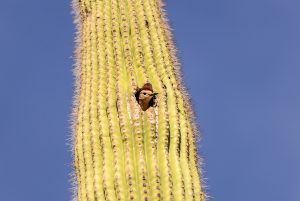
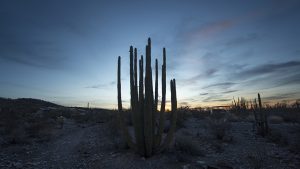
Day 8: From the Painted Desert in New Mexico to the Painted Canyon in California – Californian Geology
After a fun morning checking out the cacti at sunrise, we packed up again and made another long haul out to Mecca Hills Wilderness Area to check out the Painted Canyon, outside of Palm Springs. The relatively recent geologic activity of California is evident here, where we observed some large scale deformities along the San Andreas fault. Rock layers are upturned and exposure of rocks of all ages characterized by their different colors.
Day 9: On our way home
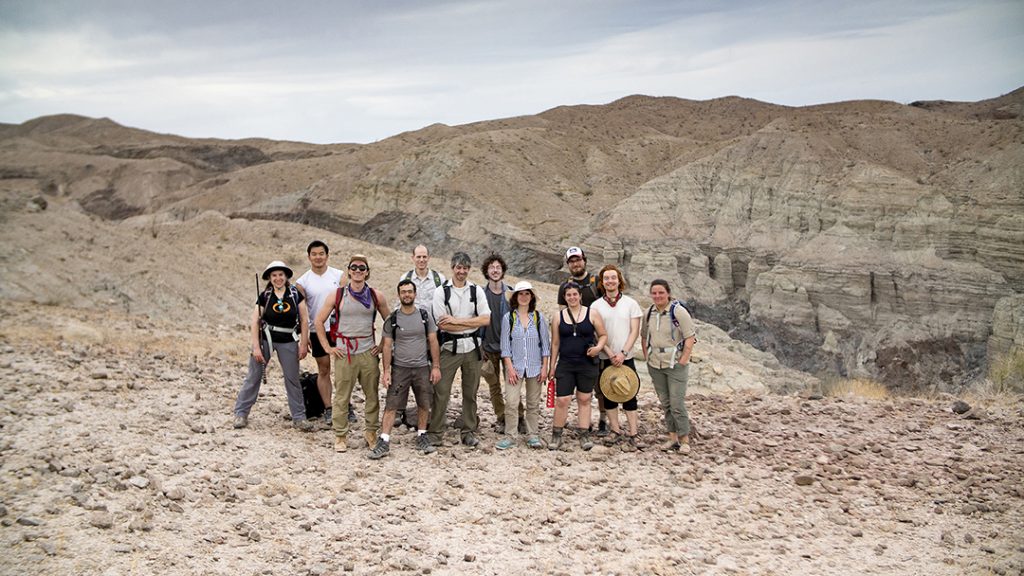
Our Spring break ended in Mecca Hills as we got on the road for our final leg of back to UC Berkeley. It was a demanding driving schedule to get there and back again but it was well worth the effort. Next year’s location is to be determined, but should be filled with fun and fossils!